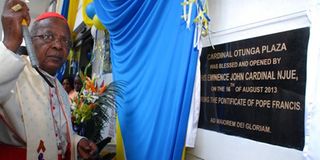Maurice Cardinal Otunga’s legacy lives on 11 years later

The Archbishop of Nairobi, John Cardinal Njue, opens the Cardinal Otunga Plaza in Nairobi on August 16, 2013. FILE PHOTO | SALATON NJAU |
What you need to know:
- The Otunga process is forging ahead in a steady and rigorous manner.
- There is much enthusiasm for the Otunga process.
It is 11 years today since the death of Maurice Cardinal Otunga, the much-loved Archbishop of Nairobi.
There have been several milestones on the prelate’s road to sainthood.
The Kenyan phase of the formal process, launched in 2009 by John Cardinal Njue, was concluded last year.
When it started, it earned Cardinal Otunga the title of Servant of God.
And it ended with the conveying to the Vatican of the evidence that had been gathered, including oral testimonies and documentary records.
The process is now completing one year since it entered the Roman phase.
The Roman phase recently reached a key milestone.
In a letter called Decree of Validity to the diocesan phase from Angelo Cardinal Amato, prefect or head of the Congregation for the Causes of Saints, to Bro Cruz, the saint-making office addressed the matter of the beatification and canonisation of Maurice Michael Otunga.
The officials at the Vatican were responding to the material sent over to Rome from Nairobi a year ago.
STEADY AND RIGOROUS
In summary, the decree said that the relevant authorities had perused the material on the life and virtues of Cardinal Otunga, his reputation for holiness, and his intercessory power, and whether the witnesses in Kenya were properly examined.
The answer to all the four questions is in the affirmative.
What is the significance of this development?
The Otunga process is forging ahead in a steady and rigorous manner.
There have been cases of processes kicked off, lagging, and finally being dropped.
One instance is the cause of the Mombasa martyrs — 288 men, women, and children, who were killed in August 1631 during a conflict involving Arabs, Portuguese, the Swahili, and other indigenous peoples on the East African coast.
Church historian Aylward Shorter writes the cause for the sainthood of the martyrs was sent to Rome by the Archbishop of Goa in 1632.
The process made some progress, but was dropped in 1636 for reasons that were not made public.
SPIRITUAL SUBSTANCE
The letter from Rome to the local Cardinal Otunga beatification office is an indicator that the Vatican is persuaded of the worth of the cause.
It is an affirmation that the life of the former prelate had spiritual substance.
In addition, the Vatican is saying that the Kenyan initiators and petitioners for Cardinal Otunga’s canonisation have done sound and solid work. In the next stage of the process, the Cardinal will be given the title “Venerable”.
There is much enthusiasm for the Otunga process.
As church and country marked the 11th anniversary of the Cardinal’s death, thousands participated in a 12-kilometre walk coordinated by Colonel (retired) Cyril Maloba and flagged off by the Archbishop of Nairobi, John Cardinal Njue, at the Holy Family Basilica.
It ended at the same venue with the celebration of Mass.
Maurice Michael Cardinal Otunga is more than just a memory. He continues to speak to those who knew him and whom he served through his holy life and works of integrity.
Prof (Fr) Njoroge teaches Development Studies at the Jomo Kenyatta University of Agriculture and Technology, where he also serves as the Catholic chaplain. ([email protected])





